Unidentified - North West Pacific (Japan, China)
A place for temporarily storing messages about species from the NW Pacific [Japan, Korea, China, etc] until they are identified. See Unidentified - General Page for an index of unidentified categories. Please make a point of looking through these messages to see if you can help identify any of them.
Authorship detailsRudman, W.B., 2001 (June 26) Unidentified - North West Pacific (Japan, China). [In] Sea Slug Forum. Australian Museum, Sydney. Available from http://www.seaslugforum.net/find/unidentjap
Related messages
Is this Flabellina sp.8 ? from Okinawa
July 2, 2008
From: Kazuko Ojima
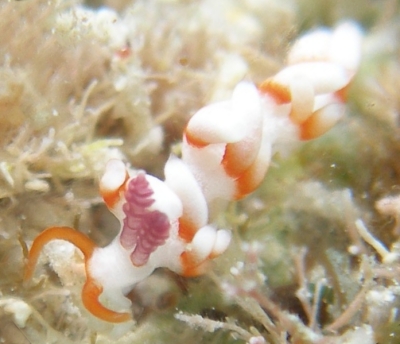
Concerning message #20104:
Dear Dr.Rudman,
Is this animal Flabellina sp.8? It looks quite like it but I think the oral tentacle's color is different. I would be very happy if I could hear your comment.
Locality: Horseshoe Cliffs,Okinawa Is., 5 metres, Japan, East China Sea, 26 March 2008. Length: 10 mm. Photographer: Kazuko Ojima.
Best Regards,
Kazuko Ojima
Kazuko.O.14.c9@gold.zero.jp
Kazuko Ojima, 2008 (Jul 2) Is this Flabellina sp.8 ? from Okinawa. [Message in] Sea Slug Forum. Australian Museum, Sydney. Available from http://www.seaslugforum.net/find/21660Dear Kazuko,
This could well be a species of Flabellina but it is quite different in colour to Flabellina sp. 8. As you say, the oral tentacles are different in colour, there are no red spots around the cerata, and the rhinophores are quite different in shape. It is possibly another unnamed species.
Best wishes,
Bill Rudman
Nudibranchs from the Yellow Sea - aeolid
June 29, 2006
From: Dong Bum Koh
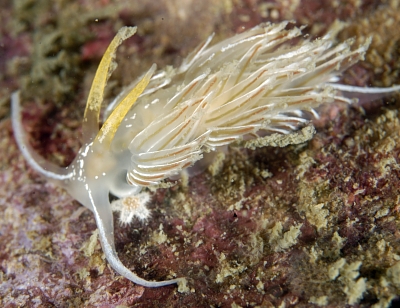
Dear Bill,
As I mentioned in my first message [#16960] sea slugs from the Yellow Sea (between China & Korea) are not well-known because poor visibility & very strong currents makes its bad for diving..
Here is another species photographed last weekend by a colleague of mine. It looks like Cuthona columbiana
Locality: Gogunsan islands, [Diving site : E 126°4' N 35°8'] 10m, Korea, Yellow Sea, 18 June 2006, Length: unknown. Photographer: Sung Soon Choi.
Best regards.
Dong Bum Koh
drkoh@seasee.co.kr
Koh, D.B., 2006 (Jun 29) Nudibranchs from the Yellow Sea - aeolid. [Message in] Sea Slug Forum. Australian Museum, Sydney. Available from http://www.seaslugforum.net/find/17009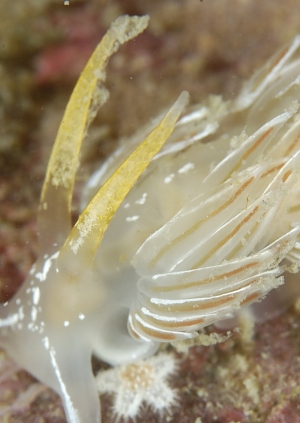
Dear Koh,
As with the last message, I suspect this is not the species you have suggested. It certainly is similar in colour to some of the forms of Cuthona columbiana but its general shape suggests to me that it is a glaucid rather than a tergipedid aeolid. One very distinct difference between the two families is that in the Tergipedidae the anterior corners of the foot are rounded while in the Glaucidae they are extended often into elongate points, tentacle-like in shape. I think that I can see one of the tentacular foot corners just above the juvenile starfish in the close-up photo alongside.
I may be quite wrong, so I would appreciate some feed-back from those with a personal knowledge of the north Pacific fauna. It doesn't seem to be a species from the west coast of Nth America, but it could be.
Best wishes,
Bill Rudman
Cuthona? from the Mariana Islands
April 12, 2006
From: Takao Urasawa
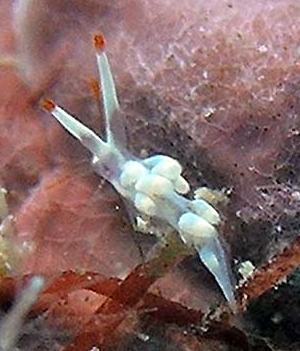
Dear Dr Rudman
Thank you for your welcome advice every time.
Is this "Cuthona "?
Locality: Laulau Beach, 11m, Saipan, Northern Mariana Islands, Pacific Ocean, 03 March 2006, Coral gravel back. Length: 2 mm. Photographer: Takao Urasawa.
Takao Urasawa
dswith@isletwnd.com
Takao Urasawa, 2006 (Apr 12) Cuthona? from the Mariana Islands. [Message in] Sea Slug Forum. Australian Museum, Sydney. Available from http://www.seaslugforum.net/find/16229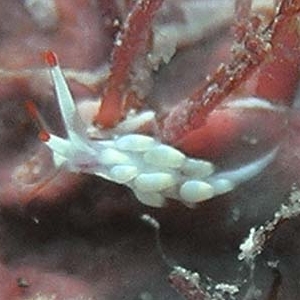
Dear Takao,
I'm afraid I admit defeat with this one. At 2 mm it most probably has not developed its adult characters. Someone with a good knowledge of your local fauna could probably link this to an adult aeolid they know from your region by similarities in its colour pattern but without such a local experience I wouldn't like to hazard a guess.
Best wishes,
Bill Rudman
Cuthona sp.(?) from eastern Russia
January 17, 2006
From: Alexei Chernyshev
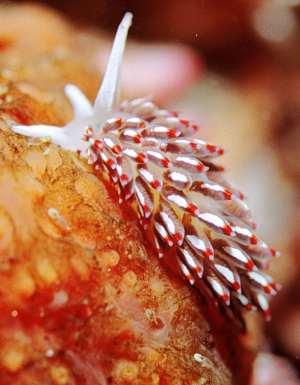
Another nudibranch was photographed by Alexei Shpatak in Japan Sea. We propose that it belongs to Cuthona.
Locality: Olga Bay, Russia, Japan Sea. Depth: 3-5 metres. Length: 12 mm, August 2005. on an ascidian. Photographer: A. Shpatak
Alexei Chernyshev
tsher@bio.dvgu.ru
Chernyshev, A.V., 2006 (Jan 17) Cuthona sp.(?) from eastern Russia. [Message in] Sea Slug Forum. Australian Museum, Sydney. Available from http://www.seaslugforum.net/find/15552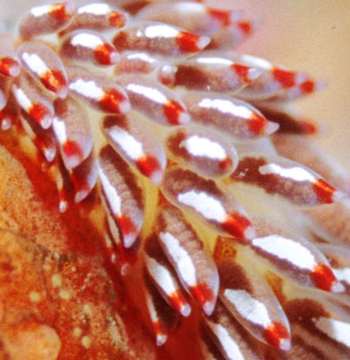
Dear Alexei,
At first I wondered whether this was a form of Cuthona yamasui. [see message #6927], a species usually assoicted with the stinging hydroid Aglaophenia. However on closer examination of your photo I see that the white on the cerata is a longitudinal band down one side only rather than the whole of the ceratal wall. I don't recognise this species off-hand, but perhaps someone from Japan or perhaps the west coast of Nth America will recognise it.
Best wishes,
Bill Rudman
Unknown dorid from Sth Korea
August 11, 2005
From: Dong Bum Koh
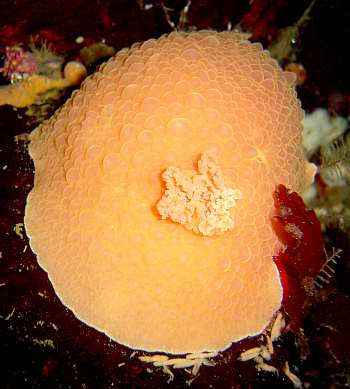
Dear Bill,
This is a photo of what I think is Tochuina tetraquetra (Pallas,1788) from South Korea.
But I'm not surel. Could you please identify this animal for me.
Locality: Go Sung, Kang Won Province, South Korea, East Sea. Depth: 20 m. Length: approx. 250 mm. Photo from: Pung Deung Publishing Co.
Best regards,
Dong Bum Koh
drkoh@seasee.co.kr
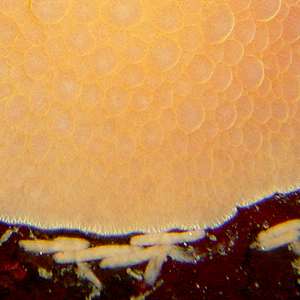
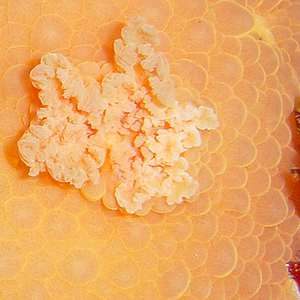
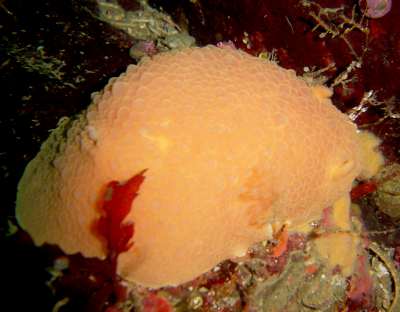
Dear Koh,
It ceratinly looks like Tochuina, but the circlet of gills in the midline, and absence of gills around the mantle edge show that it is a dorid rather than a tritoniid.
I have added a couple of close-ups to show lower left: the row of small mantle glands around the mantle edge, and the orange faecal pellets, and lower right: the 5 gills.
It is obviously feeding on the orange sponge I can see in the photo alongside. Unfortunately I can't give you a name. It looks like an Archidoris to me but I could be wrong. It is neither A. tricolor nor A. sugishimae, the two Japanese species. If anyone recognises it I would appreciate some feedback.
Best wishes,
Bill Rudman
Aeolids from East China Sea
April 23, 2005
From: QinJi
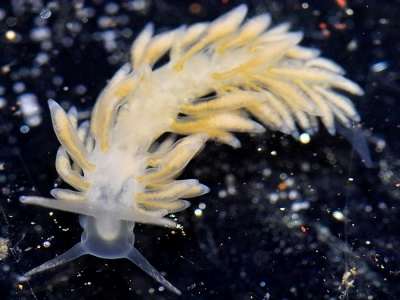
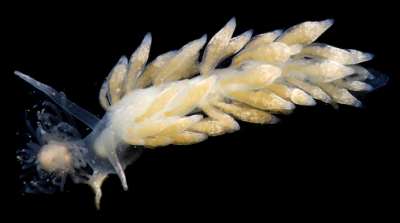
Dear Bill,
I found these very small nudis last sunday in the East China Sea. They would have been about 12-15 mm long. They were found on a hydroid colony. Would I be correct in identifying them as Eubranchidae or Sakuraeolis enosimensis?
These species haven't found in China before.
Locality: 'fishpond', Xiamen, China, East China Sea. Depth: 2 metres. Length: 10 mm.17 April 2005. on hydroids. Photographer: QinJi
QinJi
babysmile007@sina.com
QinJi, 2005 (Apr 23) Aeolids from East China Sea. [Message in] Sea Slug Forum. Australian Museum, Sydney. Available from http://www.seaslugforum.net/find/13593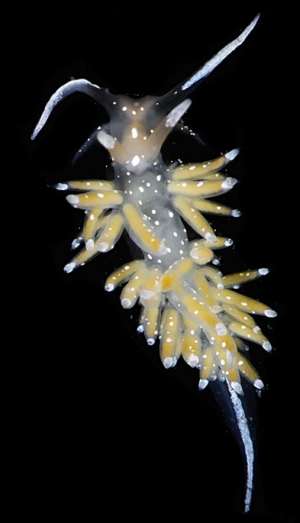
Dear AJi,
I think you have two species here. The upper two photos seem to be a species of Cuthona. The shape of the head, with the oral tentacles arising some distance in from the edge, is rather characteristic of Cuthona. Also the anterior foot corners are rounded, not developed into tentacles, another Cuthona character. Of course we would need to look, at at least the radula, to be sure.
The other photo, which I have posted alongside my reply, is quite different. You can see the oral tentacles arise right at the edge of the head and there are long tapering tentacular foot corners. These characters, and the colour pattern strongly suggest this is a juvenile Sakuraeolis enosimensis, as you thought [see separate message [#13615].
Best wishes,
Bill Rudman
Unknown Ercolania sp. from Okinawa
April 15, 2005
From: Cynthia Trowbridge
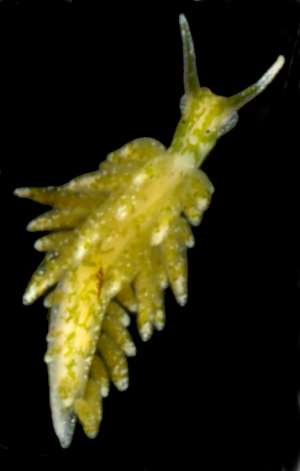
Dear Bill, Kathe, and colleagues,
During my recent trip to Okinawa, the Hiranos and I found 10 specimens of this Ercolania sp. at several sites on the green alga Boodlea. As far as I can ascertain, it is not any of the described species of Ercolania from Japan (i.e., not in Baba 1959).
I would be grateful of any suggestions of its identity. I would consider it Ercolania based on the sabot-shaped teeth (see attached photo taken with Olympus Mic-D digital microscope). Other attributes include elongate pericardium with no digestive diverticula, simple rhinophores, and branched diverticula in cerata.
The key features are the red patches mid-dorsally between the cerata [see lower right photo ]. In our 10 specimens, there was variation in the number (0-2) and placement of red patches among individuals (anterior and/or posterior to pericardium).
Locality: west coast of Okinawajima, Okinawa, Japan, East China Sea. Depth: less than 1 m. Length: several mm (data in Japan). 10-15 March 2005. shallow subtidal rocky shore. Photographer: Tomohiro Watanabe (slug) and Cynthia Trowbridge (radula)
In a message dated 16 Feb. 2002, [message #4177] Kathe mentioned an undescribed Ercolania species: "the last time I [Kathe] visited Rottnest Island, I found a few specimens of what I think is an undescribed species of Ercolania, which I think occurred on Struvea and Cladophoropsis, and which had a purple "spot" (probably the genital receptacle visible through the epidermis) in the neck."
Could this be the Australian species? or a described species not yet reported for Japan? Any thoughts would be much appreciated. Carlson & Hoff (2003) have a undescribed species (Ercolania 6) with a comparable red patch and another (Ercolania sp. 4) from Boodlea in Guam. It would be wonderful if a PhD student would study all the undescribed Ercolania spp. in the NW Pacific.
-
Baba, K. 1959. The family Stiligeridae from Japan (Opisthobranchia - Sacoglossa). Publ Seto Mar Lab 7: 327-334.
-
Carlson, C. and Hoff, P.J. 2003. The opisthobranchs of the Mariana Islands. Micronesica 35-36: 272-295.
Cordially,
Cynthia
trowbric@onid.orst.edu
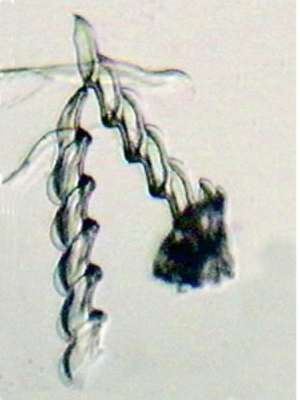
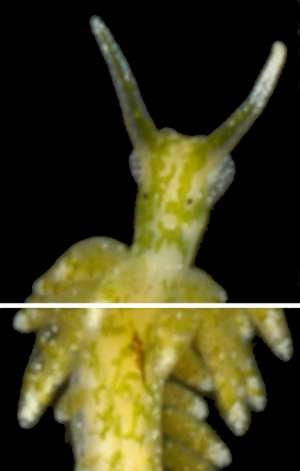
Thanks Cynthia,
Bill Rudman
Aplysiopsis sp? from Okinawa
March 24, 2004
From: Kunihiro Takahashi
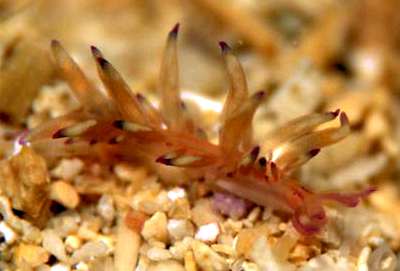
Dear Dr.Rudman,
I found this at Okinawa. I think this is Hermaea?. Could you identify this please?
Date: 25 Jan,2003
Location: Sunabe,Okinawa Japan
Depth: 20m
Length: 10mm
W/Temp: 20C degree
Photo by Kunihiro Takahashi
Best Regards,
Kunihiro Takahashi
manta9216@tontonme.ne.jp
Takahashi, K., 2004 (Mar 24) Aplysiopsis sp? from Okinawa. [Message in] Sea Slug Forum. Australian Museum, Sydney. Available from http://www.seaslugforum.net/find/12487Dear Kunihiro,
I am pretty sure this is a sacoglossan but my feeling is that it is most likely to be a species of Aplysiopsis. In general shape it looks quite like Aplysiopsis orientalis but that species is quite different in colour.
Best wishes
Bill Rudman
Re: Elysia sp? from Okinawa
March 22, 2004
From: Kathe R. Jensen
Dear Bill,
Concerning message #12435:
No, unfortunately I have never seen anything like this species anywhere.
Greetings,
Kathe
krjensen@zmuc.ku.dk
Jensen, K.R., 2004 (Mar 22) Re: Elysia sp? from Okinawa. [Message in] Sea Slug Forum. Australian Museum, Sydney. Available from http://www.seaslugforum.net/find/12484Thanks Kathe
Bill Rudman
Re: Elysia tuca? from Japan
March 22, 2004
From: Kathe R. Jensen
Dear Bill & Jun,
Concerning message #12275:
I don't think that this is Elysia tuca. Its rhinophores appear longer and thicker and the body more "transparent" than in Caribbean E. tuca. I have no suggestion for an ID at this time. Green Elysia are impossible without anatomical or feeding observations.
Greetings,
Kathe
krjensen@zmuc.ku.dk
Jensen, K.R., 2004 (Mar 22) Re: Elysia tuca? from Japan. [Message in] Sea Slug Forum. Australian Museum, Sydney. Available from http://www.seaslugforum.net/find/12485Thanks Kathe,
Bill Rudman
Re: Elysia tuca from Southern Bahamas
March 18, 2004
From: Jun Imamoto
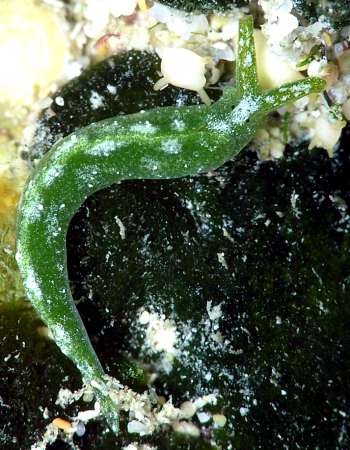
Dear Bill,
I saw Marina Poddubetskaia' message [#12254] about Elysia tuca from the Southern Bahamas and thought it looked quite like this Elysia from Japan. Is that possible from the viewpoint of distribution?
I would be very happy if I could hear your comment.
Date: 17 Jan 2004
place: Amami-Ooshima Islands, Kagoshima, Japan.
size: approx 15mm
depth: 3 m
temperature: 21 C
Best Regards,
Jun Imamoto
http://www.umiushi.info/
imamoto@umiushi.info
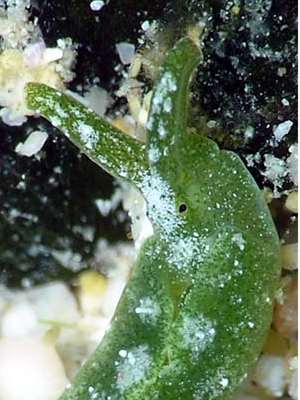
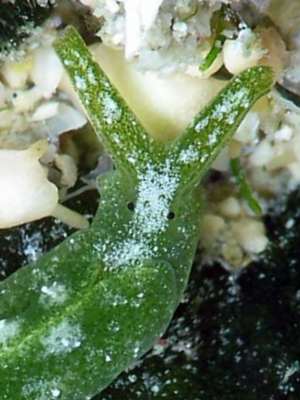
Dear Jun,
Although there is a slight similarity in colour pattern I don't think your animal is related to E. tuca. As you indicate. it certainly would not be a 'natural' distribution for a species to occur in Japan and the Caribbean. Probably of more importance than the colour differences is the probable food of each species. Elysia tuca feeds on the the calcified green algae Halimeda. I am not sure what your animals feeds on, but if it is the algae in your photo it certainly does not seem to be a species of Halimeda.
I have had a quick look through the literature but can't find a species matching the colour of your animal. Perhaps Kathe Jensen will recognise it.
Best wishes
Bill Rudman
Re: Elysia sp? from Okinawa
March 18, 2004
From: Clay & Patty Jo
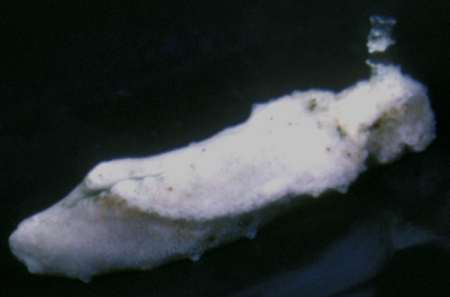
Bill,
Tried to get this to you yesterday but the scanner and I had some disagreements. This is an interesting & distinct species because of the furrowed head as well as the 'sculptured' parapodia.
Elysia sp. 4.2mm. Guam, Bile Bay, 11m. 28 May 1978. Host: ??
Clay & Patty Jo
ccarlson@kuentos.guam.net
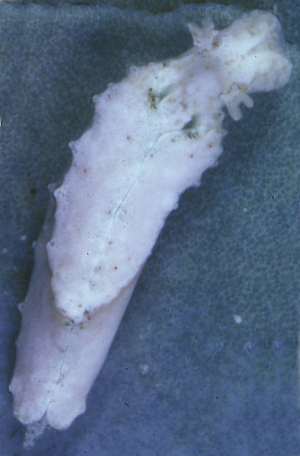
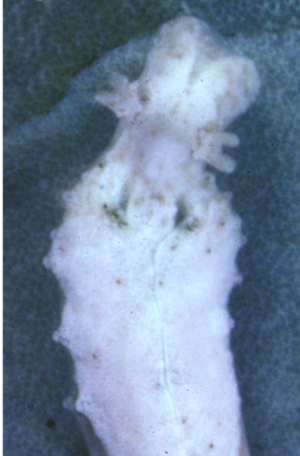
Dear Clay & Patty Jo,
This is indeed an unusual animal. The median cleft on the head looks most unusual and without the upper photo I would have been hard-pressed to agree it was an Elysia. The strange shape of the parapodia suggest it is mimicking something but I have no idea what. I wonder if Kathe Jensen has seen this in her travels
I didn't realise until I was posting this message that you must have sent it in response to the pinkish elysiid in Kunihiro Takahashi's message [#12406]. It has the same shaped parapodia although it is much more colourful. Pity we can't see the shape of the head.
Best wishes
Bill Rudman
Elysia sp? from Okinawa
March 10, 2004
From: Kunihiro Takahashi
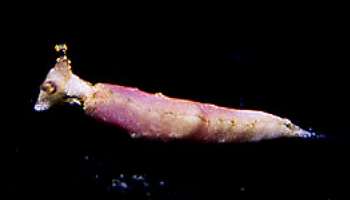
Dear Dr.Rudman,
I found this at Okinawa. I think it could be Elysiella pusilla.
Could you identify this please?
Data
Date: 29 Feb,2004
Location: Cape Maeda, Okinawa, Japan
Depth: 9m
Length: 8mm
W/Temp: 20c degree
Photo by Kunihiro Takahashi
Best Regards,
Kunihiro Takahashi
manta9216@tontonme.ne.jp
Takahashi, K., 2004 (Mar 10) Elysia sp? from Okinawa. [Message in] Sea Slug Forum. Australian Museum, Sydney. Available from http://www.seaslugforum.net/find/12406Dear Kunihiro,
This looks like a species of Elysia, but I don't recognise the colour. As it was very small this may be a juvenile colour pattern. perhaps someone will recognise it for us. The smallest Elysiella pusilla I have seen have been a uniform green colour.
Best wishes
Bill Rudman
Flabellina? from Okinawa
March 10, 2004
From: Kunihiro Takahashi
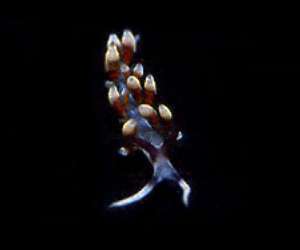
Dear Dr.Rudman,
I found this at Okinawa. Could it be a Flabellina?.
Date: 29 Feb,2004
Location: Cape Maeda, Okinawa, Japan
Depth: 6m
Length: 8mm
W/Temp: 20C degree
Photo by Kunihiro Takahashi
Best Regards,
Kunihiro Takahashi
manta9216@tontonme.ne.jp
Takahashi, K., 2004 (Mar 10) Flabellina? from Okinawa. [Message in] Sea Slug Forum. Australian Museum, Sydney. Available from http://www.seaslugforum.net/find/12407Dear Kunihiro,
Sometimes it is possible to identify small animals but other times it is very difficult. I ma pretty sure this is a juvenile, and possibly a juvenile Flabellina but I am not sure
Best wishes
Bill Rudman
Bornella? from Marianas
December 18, 2003
From: Kenji Kobayashi
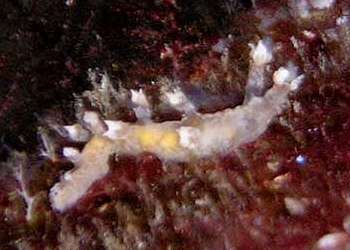
Dear Bill,
Could you identify this please?
The photos were taken in Saipan (Northern Mariana Ids).
Regards
Kenji Kobayashi
squall@gtepacifica.net
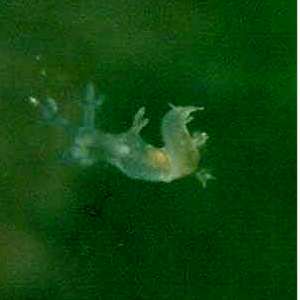
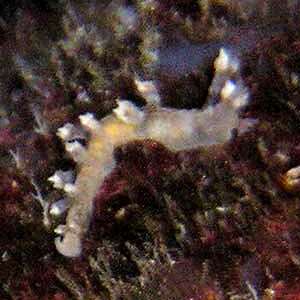
Dear Kenji,
This animal looks quite like a species of Bornella or perhaps a species of Dendronotus. If you have any higher resolution scans I might be able to see more detail. I'm afraid the photo of the swimming animal doesn't help as members of both genera can swim in this manner
Best wishes
Bill Rudman
Unidentified aeolid from Japan
July 20, 2002
From: Nishina Masayoshi
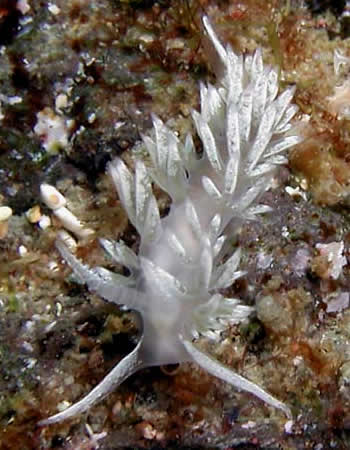
Dear Bill,
This is a common animal on the Echizen coast, but I have no idea of its name. I would be happy if you could help identify this animal.
Date: 3 May,2002
Location: Echizen coast, Japan
Length: 10mm
Depth: 4m
Photo by N.Masayoshi
Best Regards,
Nishina Masayoshi
nishina@wips.co.jp
Masayoshi, N., 2002 (Jul 20) Unidentified aeolid from Japan. [Message in] Sea Slug Forum. Australian Museum, Sydney. Available from http://www.seaslugforum.net/find/6919Dear Nishina,
The 'colour' pattern on this species, and the rings on the rhinophores should make it easily recognisable, but I'm afraid I don't recognise it. I would welcome any suggestions.
Bill Rudman
Aeolid from Sth Korea
July 5, 2002
From: Dong Bum,Koh

Dear,Bill
I can`t find this animal in my books.
Can you help me?
Data:
March 2002
Bi Yang islet (About 1km away from west coast of Che Ju island, Sth Korea)
28m depth
Photographed by Dong Bum,Koh
All the best!
Dong Bum,Koh
drkoh@seasee.co.kr
Koh, D.B., 2002 (Jul 5) Aeolid from Sth Korea. [Message in] Sea Slug Forum. Australian Museum, Sydney. Available from http://www.seaslugforum.net/find/7392Dear Dong Bum,
I don't recognise this animal at all. Perhaps someone can help us with a name. If you see it again it might be useful to know where it lives, or what it feeds on. In your photo it seems to be on a hydroid colony.
Best wishes,
Bill Rudman
Possibly Caliphyllidae species.
May 10, 2002
From: Haruo Kinoshita
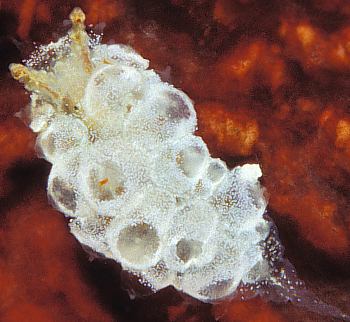
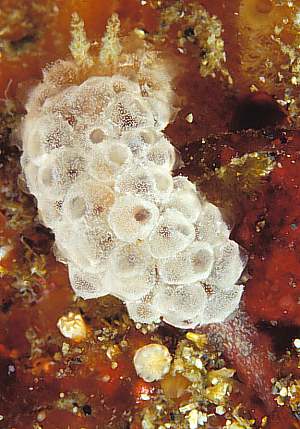
Dear Bill,
I recently went to Izu Ocean Park, Japan and found the attached animal. I found two individuals at different dive site at February 7 and 8. As for my observation of living animal, dosal papillae was just like sea-squirt. I am feeling that this is possibly one of Caliphyllidae but I can't identify further more.
Upper picture
Date : 7-Feb-2002
Location : Izu Ocean Park, Izu Peninsula, Japan
Dive site : Sanno-ne
Depth : 57m
Length : approx 10mm
Water temperature : 14c
Photo : Haruo Kinoshita
Lower picture
Date : 8-Feb-2002
Location : Izu Ocean Park, Izu Peninsula, Japan
Dive site : Burimatch
Depth : 17m
Length : approx 15mm
Water temperature : 14c
Photo : Haruo Kinoshita
Regards,
Haruo Kinoshita
kinoh@vesta.ocn.ne.jp
Kinoshita, H., 2002 (May 10) Possibly Caliphyllidae species.. [Message in] Sea Slug Forum. Australian Museum, Sydney. Available from http://www.seaslugforum.net/find/6266Dear Haruo,
I am not sure what this is. As you say, it could be a sacoglossan like Cyerce, but the rhinophores seem to have swellings on them like an aeolid nudibranch. Without some more information this is a bit of a mystery.
Best wishes,
Bill Rudman
Thuridilla from Hachijo Island, Japan
April 22, 2002
From: Shouichi Kato
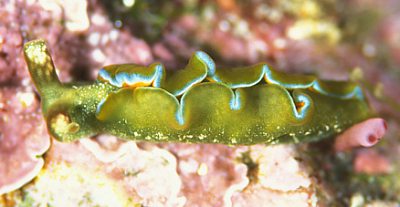
Dear Bill,
Thank you for your kind messages. I check your Forum everyday and appreciate your prompt replies. As I'm running a diving shop, I have many chances to see many seaslugs found by me, my staff and my guests. I'm collecting pictures of seaslugs in Hachijo and I hope we can introduce them as many divers as we can.
This Thuridilla was found at a shore reef, 5m in depth. 25mm in size.
Please let me know what it is.
Best regards,
S. Kato
regulus@edit.ne.jp
Kato, S., 2002 (Apr 22) Thuridilla from Hachijo Island, Japan. [Message in] Sea Slug Forum. Australian Museum, Sydney. Available from http://www.seaslugforum.net/find/6705Dear Shouichi,
This species had the orange, white and blue bordering bands found in Thuridilla livida but in that species the background colour seems to be black or at least much darker than your animal. It would be very interesting to know if anyone has photos of animals intermediate in colour between this and 'typical' T. livida.
Best wishes,
Bill Rudman
Sakuraeolis enosimensis? from Japan
April 8, 2002
From: Nishina Masayoshi
Dear Bill,
I made a careless mistake in my message about Sakuraeolis enosimensis? from Japan. The length of the animal is 15mm. Not 115mm. I am terribly sorry for my mistake.
Best Regards,
Nishina Masayoshi
nishina@wips.co.jp
Masayoshi, N., 2002 (Apr 8) Sakuraeolis enosimensis? from Japan. [Message in] Sea Slug Forum. Australian Museum, Sydney. Available from http://www.seaslugforum.net/find/6701Dear Nishina,
Thanks for the correction. I'm afraid it is still a mystery to me
Best wishes,
Bill Rudman
Sakuraeolis enosimensis? from Japan
April 6, 2002
From: Nishina Masayoshi
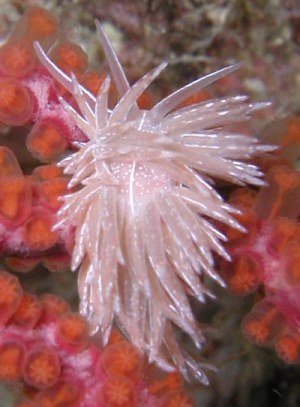
Dear Bill,
I think this is Sakuraeolis enosimensis (Baba, 1930)
AS you say in your description:
"There is a white tip to the smooth tapered rhinophores and a white line along the dorsal side of the long tapering oral tentacles. There is also a dorsal white line along the tip of the posterior foot. "
This animal has those white lines clearly.
Photographed by M. Fumiko
Data: Omijima Island, Yamaguchi pref.
Length 115mm
Best Regards,
Nishina Masayoshi
nishina@wips.co.jp
Masayoshi, N., 2002 (Apr 6) Sakuraeolis enosimensis? from Japan. [Message in] Sea Slug Forum. Australian Museum, Sydney. Available from http://www.seaslugforum.net/find/6664Dear Nishina,
This is an interesting animal. Although it has a white line on the oral tentacles, like in Sakuraeolis enosimensis, it also has a white line on the rhinophores, the cerata, and a dorsal median white line down the body, none of which are found in that species. Another unusual feature is that it seems to be crawling on a soft coral, which is not the usual food of a Sakuraeolis. It may just be passing by, but the other possibility is that this is a species of Phyllodesmium, which usually feed on soft corals. The third point of interest is the length of this animal - 115mm is quite large for an aeolid, and the largest aeolids are often species of Phyllodesmium.
Without knowing something of its anatomy I can't say any more. Perhaps someone will recognise it for us.
Best wishes,
Bill Rudman
Elysia ? from Hachijo Island, Japan
April 5, 2002
From: Shouichi Kato
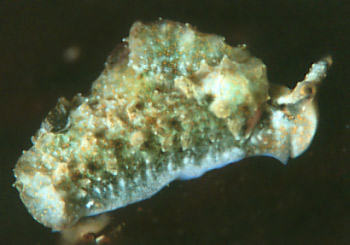
Dear Bill,
I hope you can identify this photo of an Elysia I saw last January at Hachijo Island, Japan. I saw this animal only once.
Depth : 5m
Size : 25mm
Best regards,
S. Kato
regulus@edit.ne.jp
Kato, S., 2002 (Apr 5) Elysia ? from Hachijo Island, Japan. [Message in] Sea Slug Forum. Australian Museum, Sydney. Available from http://www.seaslugforum.net/find/6522Dear Shouichi,
I sometimes wonder if there is a secret factory in Japan making new species of Elysia. Japan must have the most diverse fauna of these animals in the world. I am afraid I don't know this species either.
Best wishes,
Bill Rudman.
Is this Elysia mercieri ?
April 5, 2002
From: Nishina Masayoshi
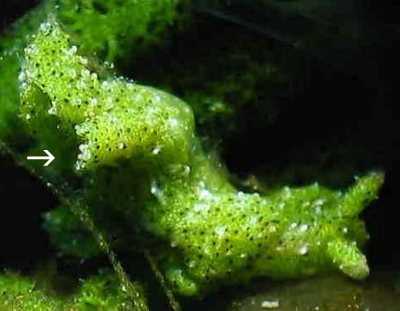
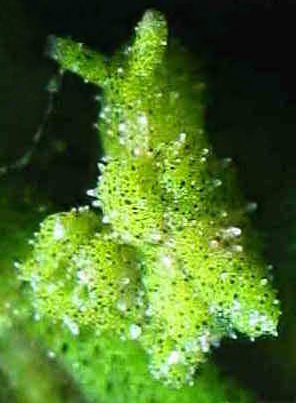
Dear Bill,
A friend of mine "Moguricyo" found and photographed this animal at Hachijyo Island Japan on 2002-March-04. Length is about 10mm. I suspect that this is Elysia mercieri or very similar animal.
This animal has dark green spots like a Pruvot-Fol described, I cannot recognize 2 or 4 dendritic papillae because of the posture but I feel it seems a one of the papillae (white arrow).
Best Regards,
Nishina Masayoshi
nishina@wips.co.jp
Masayoshi, N., 2002 (Apr 5) Is this Elysia mercieri ?. [Message in] Sea Slug Forum. Australian Museum, Sydney. Available from http://www.seaslugforum.net/find/6550Dear Nishina,
I am sorry I haven't as yet got a good photo of Elysia mercieri on the Forum but don't think this photo is that species. The branched parapodial papillae on E. mercieri are very distinctive. I am not sure what this species is but the dark green or black spots may be a useful point of distinction.
Best wishes,
Bill Rudman
Unknown from Okinawa, Japan
October 3, 2001
From: Tsuyoshi Kawamoto
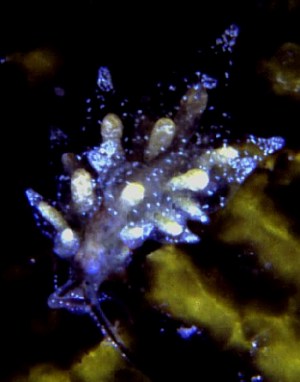
Dear Dr.Rudman
Here is another one from Kume Is, Okinawa, Japan, which I would like identified. It was photographed on 25 June 2001 on the outer reef: depth -10m., length 10mm.
Best wishes,
Tsuyoshi Kawamoto
estivant@mrh.biglobe.ne.jp
Kawamoto, T., 2001 (Oct 3) Unknown from Okinawa, Japan. [Message in] Sea Slug Forum. Australian Museum, Sydney. Available from http://www.seaslugforum.net/find/5355Dear Tsuyoshi,
I think this is a sacoglossan rather than an aeolid. There only appears to be one pair of head tentacles and the digestive gland duct in the cerata does not seem to extend to the tip. Hopefully Kathe Jensen will be able to give us an idea about this animal.
Best wishes,
Bill Rudman
Tritoniid from Okinawa
October 1, 2001
From: Tsuyoshi Kawamoto
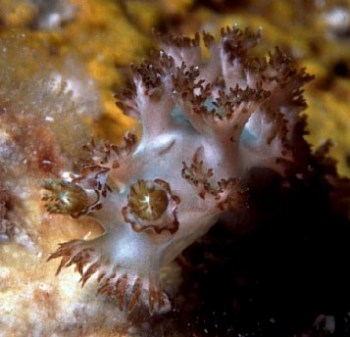
Dear Dr.Rudman
My name is Tsuyoshi Kawamoto and I manage a diving service in Kume Island, Okinawa. Being extremely interested in sea slugs, I have taken pictures of 350 types or more in seven years. I would like to ask your advice on some of these.
This one is from Kume Is, Okinawa, Japan, 25 June 2001. Outer reef., depth -25m.,length 25mm.
Tsuyoshi Kawamoto
estivant@mrh.biglobe.ne.jp
Kawamoto, T., 2001 (Oct 1) Tritoniid from Okinawa. [Message in] Sea Slug Forum. Australian Museum, Sydney. Available from http://www.seaslugforum.net/find/5017Dear Tsuyoshi,
Welcome to the Forum. I am sorry I can't give you a quick answer on your first question but perhaps someone will recognise this species. It is a tritoniid and possibly belongs to the genus Marionia but I am not sure.
best wishes,
Bill Rudman
Re: Flabellina? from Japan
September 23, 2001
From: Terry Gosliner
Dear Bill,
Toshihiro's species looks to me a lot like a juvenile of Phyllodesmium poindimiei. Let me know what you think.
All the best,
Terry
tgosline@calacademy.org
Gosliner, T., 2001 (Sep 23) Re: Flabellina? from Japan. [Message in] Sea Slug Forum. Australian Museum, Sydney. Available from http://www.seaslugforum.net/find/5304Dear Terry,
It certainly looks similar in shape but I have never seen one with obvious opaque white spots all over the body. And I am not sure if the orange on the cerata is a skin colour or from the digestive gland duct. If the latter, it doesn't suggest a finely branched structure like in P. poindimiei.
Cheers,
Bill
Re: aeolid from Hong Kong
September 21, 2001
From: Terry Gosliner
Dear Bill,
I think Leslie Chan's tergipedid is Cuthona perca, that I recorded from Hawaii. I think one of Michael Miller's species from New Zealand (maybe Cuthona reflexa) is a synonym. Let me know what you think.
All the best,
Terry
tgosline@calacademy.org
Goliner, T.M., 2001 (Sep 21) Re: aeolid from Hong Kong. [Message in] Sea Slug Forum. Australian Museum, Sydney. Available from http://www.seaslugforum.net/find/5298Thanks Terry,
As I said in my reply to Leslie, I am pretty sure it has tentacular foot corners at the anterior end of the foot which would preclude it being a species of Cuthona.
Cheers,
Bill Rudman
Noumea sp? from Japan
September 21, 2001
From: Nishina Masayoshi
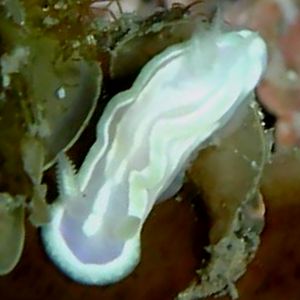
Dear Dr.Rudman,
Can you idemtify this please?
Sokodo, Hachijo Is. Japan, 8m, 29 June 2001.
Size: 10mm
Comment: Rare here. Body color is almost white to bit pale purplish white.
Best Regards,
Nishina Masayoshi
nishina@hpe15.wips.co.jp
Nishina, M., 2001 (Sep 21) Noumea sp? from Japan. [Message in] Sea Slug Forum. Australian Museum, Sydney. Available from http://www.seaslugforum.net/find/4945Dear Nishina,
I don't think this has a name as yet. There is a photo of it in Atsushi Ono's book [P. 87, Chromodoris sp 1]
Best wishes,
Bill Rudman.
Aeolid from Hong Kong
September 19, 2001
From: Leslie Chan
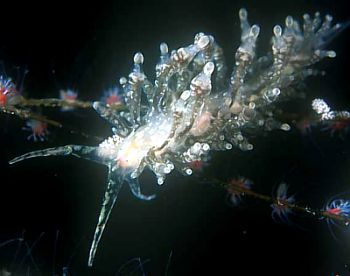
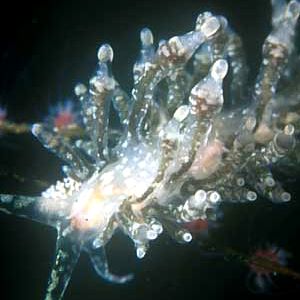
Dear Dr. Rudman
Could you please ID this nudibranch from Hong Kong? I found it feeding on a hydroid. 10m depth. 2 June 2001. Sharp Island. 1cm long
Thank you very much
Best regards
Leslie
www.marinelife.com.hk
leslie@marinelife.com.hk
Chan, L., 2001 (Sep 19) Aeolid from Hong Kong. [Message in] Sea Slug Forum. Australian Museum, Sydney. Available from http://www.seaslugforum.net/find/5203Dear Leslie,
I think I have this from Brian Darvell's collections but I will need to check. I thought at first it was a tergipedid but the long tentacular anterior foot corners are not what you expect to find in that family. I'm afraid I will have to put this one in the Unidentified file at the moment.
Best wishes,
Bill Rudman
Unknown Flabellinidae?
September 18, 2001
From: Toshihiro Horiuchi
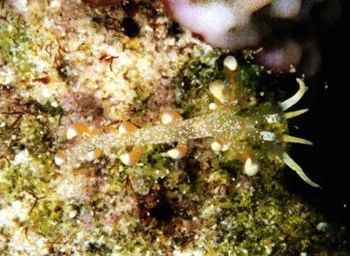
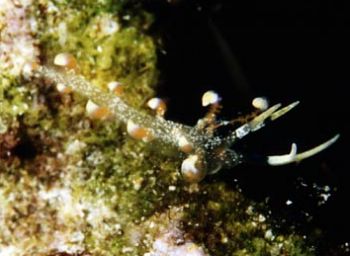
Dear Bill,
I am an amateur diver living in Tokyo, Japan. This is my first mail to this Forum.
I saw this animal at Kerama Islands, Okinawa, Japan,in Aug.2001.
It was found at 5m deep, crawling on the seaweeds. Water temperature was 29C and it was about 11mm long. I think it is perhaps a species of Flabellinidae,but I can not find it on your species list.
Could you help me to identify this?
I manage a sea slug site. It is only in Japanese at present, but I hope to open an English page in a few days.
http://homepage1.nifty.com/InTooDeep/.
Best regards,
Toshihiro Horiuchi
YRB00514@nifty.ne.jp
Horiuchi, T., 2001 (Sep 18) Unknown Flabellinidae?. [Message in] Sea Slug Forum. Australian Museum, Sydney. Available from http://www.seaslugforum.net/find/5118Dear Toshihiro,
Thanks for the photos and welcome to the Forum. Your animal certainly looks like a Flabellina, but I don't recognise the species. Perhaps someone visiting the Forum will be able to help.
Good Luck wth your website, I am very impressed with your opisthobranch models.
Best wishes,
Bill Rudman
Re: Bob Bolland's unknown 'bornellids'
September 12, 2001
From: Bill Rudman
Bob,
A day after I posted your messages ['Bornella? from Okinawa', and 'Pseudobornella? from Okinawa'] I've just noticed Baba's description of Dendronotus gracilis Baba, 1949 which was based on a single specimen approximately 25mm long. Without going into details, it seems almost identical in shape and colour to your white species. However, just to make life difficult, Baba's species has scattered yellow spots, which from the painting in Opisthobranchia from Sagami Bay look, in size and distribution, very like those on your [second species.
I suspect there is nothing much we can say until the anatomy of your two 'species' is studied and more specimens are found to see just how much variability there is bot in colour and external shape.
Cheers,
Bill Rudman
Bornella? sp. from Okinawa
September 11, 2001
From: Bob Bolland
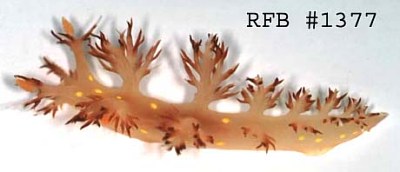
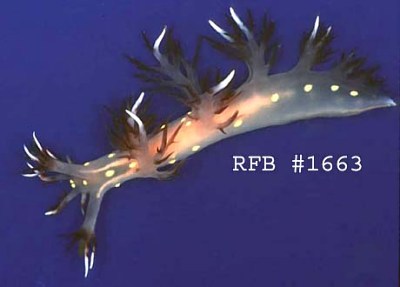
Hi Bill,
Looking at a recent post to the Forum asking about Bornella japonica, I was reminded to take a look at some of my Okinawan dendronotoid material; in doing so I came across two animals which I'd almost forgotten about from quite a few years back which I tentatively labelled "Bornella sp. (possibly undescribed?"
RFB #1377 / TL: unrecorded (ca. 30mm) / 215ft(66m) / Horseshoe Cliffs, Okinawa / 3 Jan. 1985
RFB #1663 / TL: unrecorded (ca. 30mm) / 225ft(69m) / Horseshoe Cliffs, Okinawa / 11 Apr. 1986
Cheers,
Bob
bollandr@rapid-link.ne.jp
Bolland, R.F., 2001 (Sep 11) Bornella? sp. from Okinawa. [Message in] Sea Slug Forum. Australian Museum, Sydney. Available from http://www.seaslugforum.net/find/5221Thanks Bob,
The yellow spots make this very distinctive. I don't recognise it and wouldn't be confident in putting it in the genus Bornella. If it was from cooler waters I would say it was a Dendronotus.
Best wishes,
Bill Rudman
Pseudobornella? from Okinawa
September 11, 2001
From: Bob Bolland
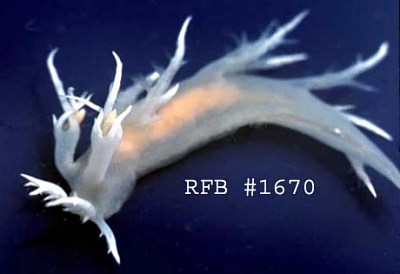
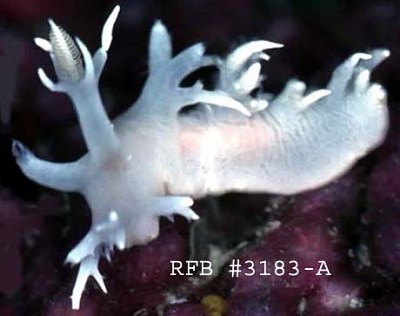
Hi Bill,
Looking at a recent post to the Forum asking about Bornella japonica, I was reminded to take a look at some of my Okinawan dendronotoid material; in doing so I came across two animals which I'd almost forgotten about from quite a few years back which I tentatively labelled 'Unknown dendronotoid (Bornella? Dendronotus?). Here is an image of each of the two different animals. Available data is as follows:
RFB #1670 / TL: unrecorded (ca. 30mm) / 225ft(69m) / Horseshoe Cliffs, Okinawa / 26 Apr. 1986
RFB #3183-A / TL: 17mm / 200ft(61m) / Horseshoe Cliffs, Okinawa / 17 May 1993
Cheers,
Bob
bollandr@rapid-link.ne.jp
Bolland, R. F., 2001 (Sep 11) Pseudobornella? from Okinawa. [Message in] Sea Slug Forum. Australian Museum, Sydney. Available from http://www.seaslugforum.net/find/5222Dear Bob,
It certainly looks like a cross between a Bornella and a Dendronotus. One thing it does remind me of is Pseudobornella orientalis Baba, 1932 which was described from a preserved animal. It has recently been illustrated in colour in Okutani (2000) - Marine Mollusks in Japan. The main external features are relatively elongate processes on the edge of the rhinophoral stalk ncluding a long thin tentacular papilla which can extend about 3 or 4 times the length of the other processes. The dorso-lateral processes (cerata) are long and tapering with a number of short rounded papillae. The animal in your upper photo has similarities to that but its white colour differs from the transparent animal of Pseudobornella orientalis with brown spots and short yellowish cream lines.
As a complete guess I will suggest it is a species of Pseudobornella but it could be a strange Dendronotus.
Best wishes,
Bill Rudman.
Polycera from Hachijo Is., Japan
July 12, 2001
From: Nishina Masayoshi
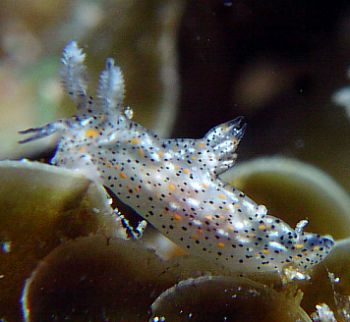
Dear Dr.Rudman,
My friend Mr.Jun Imamoto and I have just returned from Hachijo Island, Izu-Islands, about 300 k south of Tokyo, Japan
I would like to report you that he found 4 wonderful animals. They were found at 6-7M depth and size are all around 5mm, they are very small animals. I was there with him and those are very difficult to see and observe with my naked eye. I never seen those animals before but they are all so beautiful.
I hope that those images help in your research.
Best Regards,
Nishina Masayoshi
nishina@hpe15.wips.co.jp
Nishina, M., 2001 (Jul 12) Polycera from Hachijo Is., Japan. [Message in] Sea Slug Forum. Australian Museum, Sydney. Available from http://www.seaslugforum.net/find/4735Dear Nishina,
Thanks for the photos. I have separated them into separate messages. This one is a species of Polycera. It has similarities to both Polycera fujitai and Polycera abei but I need some assistance in sorting out these Japanese species.
Best wishes,
Bill Rudman
Dorid from Japan
March 28, 2001
From: Rie Nakano
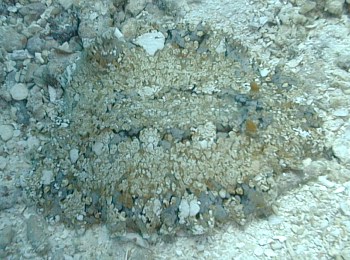
Dear Bill,
I found this animal at Ishigaki Island (Okinawa, Japan) last July [2000]. It has very hard body and the mantle is granular like a leather, over 100mm long.
What is this? I wonder this one is Hoplodoris ...?
Depth:13m (coral rubble, it burrowed under the stone)
Sincerely,
Rie
rie@street.ne.jp
Nakano, R., 2001 (Mar 28) Dorid from Japan. [Message in] Sea Slug Forum. Australian Museum, Sydney. Available from http://www.seaslugforum.net/find/3971Dear Rie,
These large flat dorids are quite variable in colour and so quite difficult to identify from a single photo. It would be quite useful to know if you have any record or photo of the underside of the mantle. Often this is a very useful character in these big animals. It is also useful with these large animals to try and take a photo close-up to show part of the mantle so we have an idea whether the mantle has tubercles or papillae etc.
Sorry I can't help
Best wishes,
Bill Rudman
Cuthona? from Japan
May 12, 2000
From: Yasuhiro Shirai
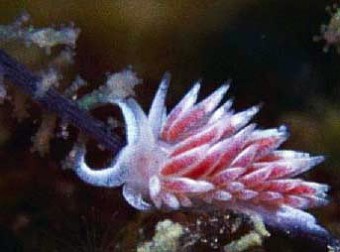
Dear Bill,
Thank you for your earlier replies.
When I found this animal,it was crawling on a hydroid. I think this animal is similar to Cuthona punicea.
Data:
Location: Kushimoto Japan
Length: 5mm
Water temperature: 16C
Date Feb. 2000
Depth: -15m
Crawling on Solanderia
Could you please identify this animal for me?
Best regards,
Yasuhiro Shirai.
yasuhiro@e-net.or.jp
Shirai, Y., 2000 (May 12) Cuthona? from Japan. [Message in] Sea Slug Forum. Australian Museum, Sydney. Available from http://www.seaslugforum.net/find/2382Dear Yasuhiro,
I don't recognise this little aeolid but someone else may. It is possible that it is Cuthona punicea which was described by sandra Millen from near Vancouver Island, British Columbia, in Canada. perhaps sandra can give us her opinion.
Best wishes,
Bill Rudman.
Dorid from Japan
March 14, 2000
From: Yasuhiro Shirai
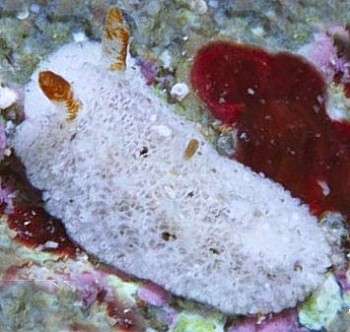
Dear Bill,
I found this animal at Shima in Japan. This animal Crawled on seaweed. Could you please identify it for me?
Data:
Location: Shima Pref. Mie, Japan (Kii Peninsula, east coast)
Length: 15mm
Water temperature: 15C
Date Feb.2000
Depth: 3m
Crawling on seaweed.
Best regards,
Yasuhiro Shirai
yasuhiro@e-net.or.jp
Shirai, Y., 2000 (Mar 14) Dorid from Japan. [Message in] Sea Slug Forum. Australian Museum, Sydney. Available from http://www.seaslugforum.net/find/2060Dear Yasuhiro,
I am sorry but I don't know whether this is an adult or a juvenile. I am afraid that some of these small greyish dorids are quite difficult to identify without a good knowledge of the local fauna. perhaps someone will recognise it
Best wishes,
Bill Rudman.
